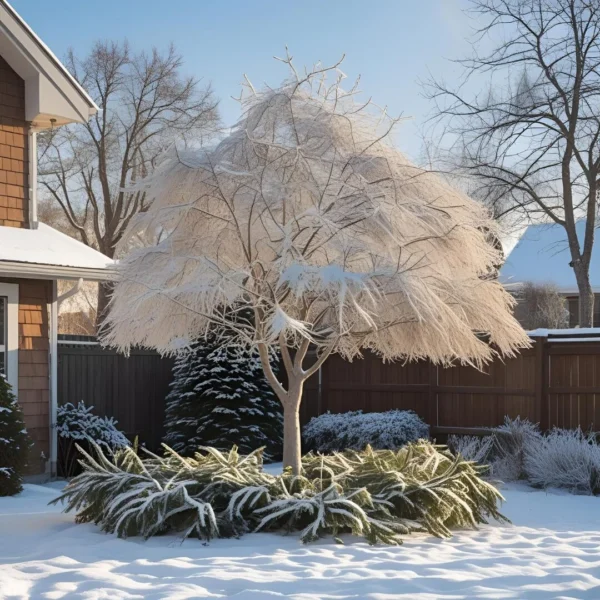Protecting trees and shrubs through winter is essential for ensuring their longevity, vigor, and year-round beauty. Winter can bring freezing temperatures, drying winds, heavy snow, ice accumulation, salt exposure, and animal damage—all of which can harm even well-established landscape plants. Fortunately, with some planning and proven techniques, gardeners can greatly reduce the risk of winter injury and promote healthy regrowth each spring. Here’s a comprehensive guide to the best ways to protect your trees and shrubs in winter.aplustree+2

1. Water Thoroughly in Autumn
Trees and shrubs with moist root zones are better equipped to survive winter stress.
-
Continue watering up until the ground freezes, especially for young or newly planted trees, evergreens, and shallow-rooted species.
-
Water during brief winter thaws if the soil is dry, which helps evergreens in particular prevent winter burn.gardeners+1
-
Avoid overwatering, which can create soggy ground and root rot.
2. Mulch for Insulation and Moisture Retention
Adding a protective layer of organic mulch—such as wood chips, pine straw, or shredded leaves—around the root zone:
-
Helps regulate and insulate soil temperature, minimizing freeze/thaw cycles
-
Conserves soil moisture against drying winter winds
-
Reduces root heaving caused by soil expansion/contraction
-
Apply mulch 2–4 inches deep in a wide ring, but keep it several inches away from the trunk to prevent rot and discourage rodents.extension.illinois+2
3. Wrap Trunks and Stems
Young trees, thin-barked species, and newly transplanted plants are especially prone to sunscald and frost cracks.
-
Use commercial tree wraps, spiraled paper, or burlap to shield trunks from sun and temperature fluctuations.
-
Wrap from the base up to the first branches and secure loosely.
-
Remove the wrap in spring to allow airflow and prevent pest/disease buildup.seedsavers+1
4. Shield from Winter Winds and Road Salt
Evergreens and broadleaf shrubs are especially sensitive to desiccation from harsh winter winds and salt spray.
-
Erect burlap screens or windbreaks on the windward side of exposed trees and shrubs.
-
Loosely wrap entire shrubs in burlap for maximum protection, allowing air and moisture exchange.rhs+1
-
Use physical barriers or plastic mesh to shield from road salt. Avoid piling salted snow against roots.
5. Protect Against Animals
Mice, voles, rabbits, and deer often feed on bark, twigs, or branches during winter scarcity.
-
Install tree guards made of wire mesh, plastic spiral wraps, or hardware cloth around trunks; ensure guards extend a few inches below ground level.
-
Use tall mesh fencing (4–6 feet) for deer, placed far enough from trunks to prevent browsing.seedsavers
-
Remove guards each spring as growth resumes.
6. Prevent Snow and Ice Damage
Heavy snow can snap branches or bend evergreens out of shape.
-
Gently brush off heavy snow accumulation with an upward motion rather than shaking branches.
-
Avoid removing ice; let it melt naturally to prevent breakage.
-
In snow-prone regions, tie or loosely wrap upright evergreens with twine or burlap to support branches.nashvilletreeconservationcorps+1
7. Avoid Late-Season Pruning and Fertilization
-
Pruning in late summer or autumn can stimulate new growth that won’t harden off before frost, making it vulnerable to winterkill.
-
High-nitrogen fertilizers in late season also encourage tender, frost-susceptible shoots.extension.illinois+1
-
Complete pruning and fertilization by mid-summer.
8. Select Hardy Species and Site Placement
-
Choose plants suited for your USDA hardiness zone.
-
Place new trees and shrubs where they are sheltered from direct winter winds—north and west exposures are most vulnerable.aplustree+1
-
Consider planting evergreens on the north to act as living windbreaks.
9. Protect Potted Trees and Shrubs
-
Move containers to sheltered, unheated spaces, group together for warmth, and wrap pots with insulating materials like bubble wrap or hessian.
-
For hardy potted plants, bury pots in the ground or mulch thoroughly.rhs
Table: Checklist for Winter Tree & Shrub Protection
| Protection Strategy | Main Benefits | Application Tips |
|---|---|---|
| Deep autumn watering | Prevents root desiccation | Water until freeze; during thaws |
| Mulching | Insulates soil, conserves moisture | 2–4”, keep away from trunk |
| Trunk wrapping | Prevents sunscald, frost crack | Remove in spring |
| Burlap windbreaks | Shields from wind & salt spray | Erect before hard frost |
| Animal guards/fencing | Deters rodents and deer | Check/adjust regularly |
| Tie/support uprights | Prevents snow/ice breakage | Use twine or burlap loosely |
| Pruning/fert timing | Avoids vulnerable late growth | Finish by mid-summer |
| Hardy placement/selection | Ensures climate suitability | Research hardiness zone |
| Potted plant protection | Prevents freeze damage in containers | Group & insulate, or bury pots |
Additional Tips
-
Use anti-desiccant sprays on evergreens in late fall to reduce moisture loss (avoid if rain is forecast soon after application).extension.illinois
-
Clear turf and weeds at the base of trees for better soil insulation.
-
Remove any dead, diseased, or broken branches before winter to reduce storm damage risk.
Conclusion
Winter poses many challenges for trees and shrubs, but informed, early action makes all the difference. By supplying water, insulating roots, shielding bark and foliage, protecting against animals, and selecting the right plants and locations, your landscape can weather winter and burst back beautifully each spring. Invest a bit of care in fall, and reap years of healthy, resilient trees and shrubs when the snow melts.gardeners+3
- https://aplustree.com/winter-tree-protection/
- https://www.gardeners.com/how-to/winter-protection/8644.html
- https://bioadvanced.com/tree-care-prepping-new-trees-winter
- https://www.lawnstarter.com/blog/tree-care/how-to-protect-trees-from-freeze/
- https://extension.illinois.edu/news-releases/protect-trees-winters-wrath-few-preventive-steps
- https://seedsavers.org/prepare-fruit-trees-for-winter/
- https://www.rhs.org.uk/prevention-protection/preventing-winter-damage
- https://www.nashvilletreeconservationcorps.org/treenews/diy-winter-tree-care
- https://crofttreeexperts.ca/blog/preparing-trees-for-winter/






